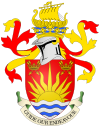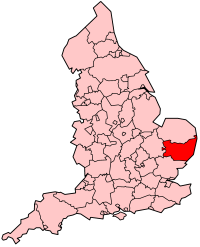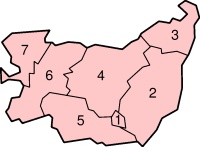Suffolk
| Suffolk | |
|---|---|
 |
|
| Motto of County Council: Guide Our Endeavour | |
 |
|
| Geography | |
| Status | Ceremonial & Non-metropolitan county |
| Region | East of England[1] |
| Area - Total - Admin. council |
Ranked 8th 3,801 km² (1,468 sq mi) Ranked 7th |
| Admin HQ | Ipswich |
| ISO 3166-2 | GB-SFK |
| ONS code | 42 |
| NUTS 3 | UKH14 |
| Demography | |
| Population - Total () - Density - Admin. council |
31st 709,300 187/km² (484/sq mi) Ranked 13th |
| Ethnicity | 97.2% White |
| Politics | |
| Suffolk County Council www.suffolk.gov.uk |
|
| Executive | Conservative |
| Members of Parliament |
Bob Blizzard (L) |
| Districts | |

|
|
Suffolk (pronounced /ˈsʌfək/) is a non-metropolitan county of historic origin in East Anglia, England. It has borders with Norfolk to the north, Cambridgeshire to the west and Essex to the south. The North Sea lies to the east. The county town is Ipswich, at and other important towns include Lowestoft and Bury St Edmunds. Felixstowe is one of the largest container ports in Europe.[2]
The county is low-lying with few hills, and is largely wetland habitat and arable land with the wetlands of The Broads in the North. The Suffolk Coast and Heaths are an Area of Outstanding Natural Beauty.
Contents |
History
Suffolk was part of the kingdom of East Anglia which was settled by the Angles in the 5th century.
Suffolk was divided into separate Quarter Sessions divisions. These were originally four in number, reduced to two in 1860: the eastern division being administered from Ipswich and the western from Bury St Edmunds. The two divisions were made separate administrative counties as East Suffolk and West Suffolk under the Local Government Act 1888, with Ipswich becoming a county borough.
Under the Local Government Act 1972, East Suffolk, West Suffolk and Ipswich were merged to form a unified county of Suffolk on April 1, 1974. This was divided into several local government districts: Babergh, Forest Heath, Ipswich, Mid Suffolk, St. Edmundsbury, Suffolk Coastal, Waveney. This also saw a further part of land near Great Yarmouth become part of Norfolk. As introduced into Parliament, the Local Government Bill would have included Newmarket and Haverhill into Cambridgeshire, with it being compensated by the inclusion of Colchester from Essex: these proposals were ultimately decided against.
In 2007 the Department for Communities and Local Government referred Ipswich Borough Council's bid to become a new unitary authority to the Boundary Committee.[3][4] The Boundary Committee consulted local bodies and reported in favour of the proposal. It was not, however, approved by the Secretary of State for Communities and Local Government.
In 2008, the Boundary Committee's review of local government throughout Suffolk (and Norfolk)[5]resulted in a recommendation for an enlarged Ipswich and Felixstowe unitary authority, with the remainder of Suffolk (minus Lowestoft, to be annexed to Norfolk) forming another unitary. Suffolk County Council would then cease to exist.
This proposal is highly controversial and has found little or no acceptance in Suffolk outside the area of Ipswich. If the status quo is not to continue, the more generally preferred and expressed option for Suffolk is that of three unitaries; namely Ipswich (probably incorporating some surrounding areas), East Suffolk and West Suffolk. The consultation period closed on 26th September 2008, with final recommendations to Government by 31st December, 2008. Thereafter,a decision will be made by the Secretary of State for Communities and Local Government. As of August 2008, the future organisation of the County remains uncertain; although it is likely that Ipswich will in some form become a unitary in 2010.
West Suffolk is, like nearby East Cambridgeshire, renowned for archaeological finds from the Stone Age, the Bronze Age and the Iron Age. Bronze Age artefacts have been found in the area between Mildenhall and West Row, in Eriswell and in Lakenheath[6]. Many bronze objects, such as swords, spear-heads, arrows, axes, palstaves, knives, daggers, rapiers, armour, decorative equipment (in particular for horses) and fragments of sheet bronze, are entrusted to the Moyse's Hall Museum in Bury St Edmunds. Other finds include traces of cremations and barrows.
Economy
The majority of agriculture in Suffolk is either arable or mixed. Farm sizes vary from anything around 80 acres to over 8,000. Soil types vary from heavy clays through to light sands. Crops grown include winter wheat, winter barley, sugar beet, oil seed rape, winter and spring beans and linseed, although smaller areas of rye and oats can be found in lighter areas along with a variety of vegetables.
This is a chart of trend of regional gross value added of Suffolk at current basic prices published (pp.240-253) by Office for National Statistics with figures in millions of British Pounds Sterling.
| Year | Regional Gross Value Added[fn 1] | Agriculture[fn 2] | Industry[fn 3] | Services[fn 4] |
|---|---|---|---|---|
| 1995 | 7,113 | 391 | 2,449 | 4,273 |
| 2000 | 8,096 | 259 | 2,589 | 5,248 |
| 2003 | 9,456 | 270 | 2,602 | 6,583 |
- See also: Companies based in Suffolk
Well-known companies in Suffolk are Greene King and Branston Pickle in Bury St Edmunds. Birds Eye have their largest UK factory in Lowestoft, where all their meat products and frozen vegetables come from. Huntley & Palmers biscuit company are now in Sudbury. The UK horse racing industry is based in Newmarket. There are two USAF bases in the west of the county close to the A11. Sizewell B nuclear power station is at Sizewell on the coast near Leiston. Bernard Matthews have some processing units in the county, specifically Holton. Southwold is the home of Adnams Brewery. Felixstowe is an important port, and is the largest container port in the United Kingdom. BT has its main research and development facility at Martlesham Heath.
Geology, landscape and ecology
Much of Suffolk is low-lying on Eocene sand and clays. These rocks are relatively unresistant and on the coast are eroded rapidly. Coastal defences have been used to protect several towns, but several cliff-top houses have been lost to coastal erosion in the past. The continuing protection of the coastline and the estuaries, including the Blyth, Alde and Deben, is, in 2008, a matter of considerable discussion. [7]
The coastal strip to the East contains an area of heathland known as "The Sandlings" which runs almost the full length of the coastline.[8]
The west of the county lies on more resistant Cretaceous Chalk. This chalk is the north-eastern extreme of the Southern England Chalk Formation that stretches from Dorset in the south west to Dover in the south east. The Chalk is less easily eroded so forms the only significant hills in the county. The highest point of the county is Great Wood Hill, the highest point of the Newmarket Ridge, near the village of Rede which reaches 128 m (420 ft).
Demographics
The Census 2001 Suffolk recorded a population of 668,548. Between 1981 and 2001 the population of the county grew by 13%, with the district of Mid Suffolk growing fastest at 25%. The population growth is due largely to migration rather than natural increase. There is a very low population between the ages of 15 and 29 as the county has few large towns and institutions of higher education, though the 15-to-29 population in Ipswich is average. There is a larger population over the age of 35, and a larger than average retired population.
Most English counties have nicknames for people from that county, such as a Tyke from Yorkshire and a Yellowbelly from Lincolnshire; the traditional nickname for people from Suffolk is 'Suffolk Fair-Maids', or 'Silly Suffolk', referring respectively to the supposed beauty of its female inhabitants in the Middle Ages, and to the long history of Christianity in the county and its many fine churches (from Anglo-Saxon selige, originally meaning holy).
Cities, towns and villages
The agreed-upon number of established communities in Suffolk varies greatly because of the large number of the all but non-existent hamlets which may consist of just a single farm and a deconsecrated church: remnants of wealthy communities, some dating back to the early days of the Christian era. Suffolk encompasses one of the most ancient regions of the UK: A monastery in Bury St. Edmunds founded in 630AD, plotting of Magna Carta in 1215; the oldest documented structural element of a still inhabited dwelling in Britain found in Clare.
This comparatively recent evidence is but a coda to the widespread settlement in the region shown by earlier archaeological evidence of Mesolithic man as far back as c.7000BC, (Grimes Graves, Norfolk - a 5000 y/o flint mine) with Roman settlements Lakenheath, Long Melford, later Bronze and Saxon settlements. Sutton Hoo: burial ground of the Anglo-Saxon pagan kings of East Anglia.
- For a full list of settlements see the List of places in Suffolk.
Notable people from Suffolk

- See also: People from Suffolk
In the arts, Suffolk is noted for having been the home to two of England's best regarded painters, Thomas Gainsborough[9] and John Constable - the Stour Valley area is branded as "Constable Country"[10] - and one of its most noted composers, Benjamin Britten.[11] Other artists of note from Suffolk include the cartoonist Carl Giles (a bronze statue of his character "Grandma" to commemorate this is located in Ipswich town centre), poet Robert Bloomfield,[12] writer and editor Ronald Blythe, actors Ralph Fiennes and Bob Hoskins, musician and record producer Brian Eno and Dani Filth, singer of the Suffolk-based black metal group, Cradle of Filth. Hip-hop DJ Tim Westwood is originally from Suffolk and the influential DJ and radio presenter John Peel made the county his home.[13]
Suffolk's contributions to sport include Formula 1 magnate Bernie Ecclestone and England footballers Terry Butcher, Kieron Dyer and Matthew Upson. Due to Newmarket being the centre of British horseracing many jockeys have settled in the county, including Lester Piggott and Frankie Dettori.
Significant ecclesiastical figures from Suffolk include former Archbishop of Canterbury, Simon Sudbury, Tudor Catholic cardinal Thomas Wolsey, and author, poet and Benedictine monk John Lydgate
Other significant persons from Suffolk include the Suffragette, Dame Millicent Garrett Fawcett, captain of HMS Beagle, Robert FitzRoy, Witch-finder General Matthew Hopkins and both Britain's first female physician and mayor, Elizabeth Garrett Anderson. Charity leader Sue Ryder settled in Suffolk and based her charity in Cavendish. The Springs of Lavenham, an influential noble family of the Middle Ages also have their family seat in Suffolk.
St Edmund
King of East Anglia and Christian martyr St Edmund (after whom the town of Bury St Edmunds is named) was killed by invading Danes in the year 869. St Edmund was the patron saint of England until he was replaced by St George in the thirteenth century.
2006 saw the failure of a campaign to have St Edmund named as the patron saint of England, but in 2007 he was named patron saint of Suffolk, with St Edmund's Day falling on 20th November. His flag will be flown in Suffolk on that day.[14]
Education
Primary and Secondary
See also List of schools in Suffolk
Suffolk has a comprehensive education system with fourteen independent schools. Unusually for the UK, most of Suffolk has a 3-tier school system in place with Primary Schools (ages 5-9), Middle Schools (ages 9-13) and Upper Schools (ages 13-16). However, a 2006 Suffolk County Council study has concluded that Suffolk should move to the 2-tier school system used in the majority of the UK. [15] The exception to this is in the Ipswich district and parts of the districts of Suffolk Coastal, Mid Suffolk, and Babergh, where the more common 11-16 age schools are in place. All of the county's Upper schools have a sixth form as there are at present (2008) no specific sixth form colleges (though most further education colleges in the county offer A-level courses). In terms of school population, Suffolk's individual schools are large with the Ipswich district with the largest school population and Forest Heath the smallest, with just two schools.
Tertiary
University Campus Suffolk, a collaboration between the University of Essex, the University of East Anglia, partner colleges and local government, began accepting its first students in September 2007. The main Ipswich based waterfront campus building is due for completion in September 2008 [16]. Prior to this Suffolk was one of the few English counties not to contain a University campus.
Sport
Football
The county's sole professional football club is Ipswich Town. Formed in 1878, the club were Football League champions in 1961–62, FA Cup winners in 1977–78 and UEFA Cup winners in 1980–81.[17] Ipswich Town currently play in the Football League Championship - the next highest ranked teams in Suffolk are Bury Town and A.F.C. Sudbury of the Southern League Division One Midlands.
Horse racing
The town of Newmarket is the headquarters of British horseracing - home to the largest cluster of training yards in the country, many key horse racing organisations and Newmarket Racecourse. Point to point racing takes place at Higham and Ampton.[18]
Speedway
Speedway racing has been staged in Suffolk since at least the 1950s, following the construction of the Foxhall Stadium, just outside Ipswich, home of the Ipswich Witches. The Witches are currently members of the Speedway Elite League, the UK's top division. Speedway Premier League team Mildenhall Fen Tigers are also from Suffolk.
Cricket
Suffolk C.C.C. compete in the Eastern Division of the Minor Counties Championship.[19] The club has won the championship three times outright and has shared the title one other time as well as winning the MCCA Knockout Trophy once.[20] Home games are played in Bury St Edmunds, Copdock, Exning, Framlingham, Ipswich and Mildenhall.[21]
Suffolk in popular culture
The Rendlesham Forest Incident is one of most famous UFO events in England and is commonly referred to as "Britain's Roswell". The Fourth Protocol, a novel written by Frederick Forsyth and published in August 1984, is a Cold War spy thriller. It is partly set in Suffolk and was made into a film starring Michael Caine and Pierce Brosnan. A TV series about a British antiques dealer, Lovejoy, was filmed in various locations in Suffolk.[22] The reality TV Series Space Cadets was filmed in Rendlesham Forest, although the producers pretended to the participants that they were in Russia.
See also
- List of places of interest in Suffolk
- Suffolk Youth Orchestra
Notes
References
- ↑ Hierarchical list of the Nomenclature of Territorial Units for Statistics and the statistical regions of Europe The European Commission, Statistical Office of the European Communities (retrieved 06 January 2008)
- ↑ Felixstowe South reconfiguration inspector's report Department for Transport
- ↑ Unitary Ipswich - Ipswich's bid for unitary status
- ↑ Communities and Local Government - Proposals for future unitary structures: Stakeholder consultation
- ↑ Electoral commission - Suffolk Structural Review 2008
- ↑ Hall, David. Fenland survey : an essay in landscape and persistence / David Hall and John Coles. London; English Heritage. ISBN 1-85074-477-7., p. 81-88
- ↑ "Sea Defences to be saved" East Anglian Daily Times - 29th October 2008
- ↑ Suffolk Coast and Heaths
- ↑ "Biography". Gainsborough's House. Retrieved on 2008-10-30.
- ↑ "Constable Country walk". The National Trust. Retrieved on 2008-10-30.
- ↑ "Intervews: Benjamin Britten 1913 - 1976". BBC Four online. Retrieved on 2008-10-30.
- ↑ Cousin, John W.. "A Short Biographical Dictionary of English Literature". Project Gutenberg. Retrieved on 2008-10-30.
- ↑ Lusher, Adam (2006-10-21). "John Peel leaves his wife £1.5m, oh, and 25,000 records". The Daily Telegraph. Retrieved on 2008-11-14.
- ↑ "St. Edmund will be Suffolk's patron saint" East Anglian Daily Times 23rd April 2007
- ↑ "Middle Schools Under Threat" Suffolk Free Press - Dec 2006
- ↑ University Campus Suffolk - Ipswich
- ↑ "Club honours". Ipswich Town F.C.. Retrieved on 2008-04-14.
- ↑ "Courses". www.pointingea.com. Retrieved on 2008-04-14.
- ↑ "Minor Counties Cricket Association". =Cricinfo. Retrieved on 2008-08-27.
- ↑ "Minor Counties Roll of Honour". www.ecb.co.uk. Retrieved on 2008-08-27.
- ↑ "Minor County Grounds". Cricinfo. Retrieved on 2008-08-27.
- ↑ "Lovejoy" (1986) - Filming locations
External links
|
|||||